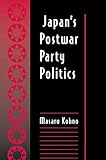Japan's Postwar Party Politics / Masaru Kohno.
Material type: TextPublisher: Princeton, NJ : Princeton University Press, [2020]Copyright date: ©1997Description: 1 online resource (172 p.) : 8 line illusContent type:
TextPublisher: Princeton, NJ : Princeton University Press, [2020]Copyright date: ©1997Description: 1 online resource (172 p.) : 8 line illusContent type: - 9780691221618
- POLITICAL SCIENCE / History & Theory
- American Occupation
- Ashida, Hitoshi
- Audience cost
- Confucianism
- Constitution
- Democratic Socialist Party (DSP)
- Dodge Economic Plan
- Electoral reform
- GHQ (General Headquarters)
- Hata, Tsutomu
- Hosokawa, Morihiro
- Ikeda, Hayato
- Inukai, Ken
- Ishii, Mitsujiro
- Japan New Party (JNP)
- Japan Socialist Party (JSP)
- Katayama, Tetsu
- Kishi, Nobusuke
- Labor movement
- Lifetime employment system
- Miki, Bukichi
- National Cooperativist Party
- Nishio, Suehiro
- Ogata, Taketora
- Ozawa, Ichiro
- Postwar reform
- Sakigake
- Takemura, Masayoshi
- Takeshita, Noboru
- Uehara, Etsujiro
- Vertical society
- Yoshida, Shigeru
- online - DeGruyter
| Item type | Current library | Call number | URL | Status | Notes | Barcode | |
|---|---|---|---|---|---|---|---|
 eBook
eBook
|
Biblioteca "Angelicum" Pont. Univ. S.Tommaso d'Aquino Nuvola online | online - DeGruyter (Browse shelf(Opens below)) | Online access | Not for loan (Accesso limitato) | Accesso per gli utenti autorizzati / Access for authorized users | (dgr)9780691221618 |
Browsing Biblioteca "Angelicum" Pont. Univ. S.Tommaso d'Aquino shelves, Shelving location: Nuvola online Close shelf browser (Hides shelf browser)

|

|

|

|

|

|

|
||
| online - DeGruyter Bismarck and the Development of Germany : The Period of Unification, 1815-1871 / | online - DeGruyter Muslims through Discourse : Religion and Ritual in Gayo Society / | online - DeGruyter The Discovery of Things : Aristotle's Categories and Their Context / | online - DeGruyter Japan's Postwar Party Politics / | online - DeGruyter Francis Bacon / | online - DeGruyter Experts and Politicians : Reform Challenges to Machine Politics in New York, Cleveland, and Chicago / | online - DeGruyter Sex and Consequences : Abortion, Public Policy, and the Economics of Fertility / |
Frontmatter -- CONTENTS -- LIST OF FIGURES -- LIST OF TABLES -- ACKNOWLEDGMENTS -- JAPAN'S POSTWAR PARTY POLITICS -- ONE Introduction -- TWO Questioning Conventional Approaches -- THREE The Politics of Electoral Reform, 1945-1947 -- FOUR Coalition Building under the Pre-1955 Multiparty System -- FIVE The Creation of the Liberal Democratic Party in 1955 -- SIX The Evolution of the LDP's Intraparty Politics -- SEVEN Post-1955 Changes in the Japanese Party System -- EIGHT The Political Change in 1993 -- NINE Conclusion -- BIBLIOGRAPHY -- SUBJECT INDEX -- AUTHOR INDEX
restricted access online access with authorization star
http://purl.org/coar/access_right/c_16ec
In this sophisticated theoretical work, Masaru Kohno presents a systematic reexamination of the evolution of party politics in Japan since the end of the second World War. Because of the long one-party dominance by the Liberal Democratic Party, Japan's parliamentary democracy has often been viewed as unique in the developed world, and most of the existing studies of Japanese party politics have addressed such determinants as its political culture, historical background, and socio-ideological cleavages. According to the author, these explanations do not adequately account for some of the most important changes that took place in Japanese party politics during the postwar period. This study advances an alternative set of interpretations based on a microanalytic approach that highlights the incentive and bargaining power of individual political actors, and their competitive and strategic behavior under existing institutional constraints. According to Kohno, the evolution of political life in postwar Japan depends on the same factors that are acknowledged to be at work in other industrialized nations. He reveals, through detailed case studies of government formation processes and statistical examinations of candidate nomination patterns, that the microanalytic approach can establish forward-looking and internally consistent interpretations of the postwar development of Japanese party politics. Because Japan has usually been treated as a country of unique cultural, historical, and societal characteristics, the analyses of this study point to the broader applicability of the microanalytic approach in the field of comparative politics, especially for the exploration of party competition in advanced industrial democracies.
Mode of access: Internet via World Wide Web.
In English.
Description based on online resource; title from PDF title page (publisher's Web site, viewed 27. Jan 2023)


